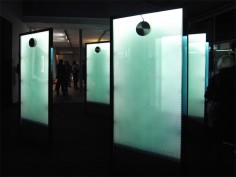KAZUHIRO YAMANAKA
sound cloud
source: tokyodesignweekjp
ロンドンを拠点に活躍するデザイナーの山中一宏氏がSaazsの「A Glass House」プログラムのために発光性Quantum Glassのスピーカーシステム「Sound Cloud」を開発しました。このシステムは5枚のがっしりしたインターアクティブなガラスパネルからなり、建築とデザインにおける画期的なガラスの統合のモデル化という意図によって構成されています。「Sound Cloud」から放たれる音と光が同時にシフトし、視聴者がタッチスクリーンコントローラーを用いて彼らの聴覚及び視覚的経験を調整するとこれらのシンクロナイゼーションが変化するようになっています。
山岡氏は来場者たちに「前後にジャンプしたりパネルから反響しながら、ひとつの場所から別の場所に移動する音を聴いて欲しい」と所望しています。
音源モジュールが各パネルに取り付けられています。それが振動すると3層のガラスが最適な音質を生み出す周波数で動きます。インスタレーションのための音源はフランスに拠点を置くサウンドデザイナー、Gling-Glangによって開発されました。山中氏とGling-Glangは、設置されたガラスパネルの経路を歩き回る中で「Sound Cloud」の来場者が音楽の彫刻的な構築を感じることができるようなサウンドスケープを発明したのです。
ガラスパネルはQuantum Glassが発明した「LED in Glass」で有名な発光システムを装備しています。この技術を通してパネルは光源となります。特別なクリアガラスシートの縁を透過する光線を導くためにパネルの縁の周りに取り付けられているLEDのバーによって「Sound Cloud」は光り輝きます。その結果、反対側の白エナメルスクリーンプリントによる正面から光屈折が生じます。氏は雲のような形態をなす何百万もの光のドットで薄い膜を作るガラスのサウンドシステムの輝きをわずかに曖昧にしています。
.
.
.
.
.
.
.
source: designboom
london-based designer kazuhiro yamanaka has created the ‘sound cloud’ a light-emitting quantum glass speaker system installation for saazs ‘a glass house’ program. the structure is composed of five interactive monolithic glass panels, formed with the intention of modelling the integration of innovative glass within architecture and design. the sound and light radiating from ‘sound cloud’ shift in unison, their synchronization may be altered by the viewer as they adjust their aural and visual experience by means of a touch-screen controller.
yamanaka aspired for the visitors to ‘be able to hear the sound move from one to another, jumping back and forth and echoing from the panels.’
a sound module is attached to each panel. as it vibrates,the three layers of glass move at a frequency, which creates optimum sound quality. the sound for the installation was developed by the france-based sound designer, gling-glang. yamanaka and gling-glang devised a soundscape by which ‘sound cloud’ visitors were able to sense the sculptural construction of the music in walking through the installation’s glass-paneled pathway.
the glass is outfitted with a light-emitting system known as ‘LED in glass’, invented by quantum glass. through this technology, the panels become a source of light. the ‘sound cloud’ is illuminated as the LED bars are fitted around the edge of the panel in order to direct beams of light through the edge of the extra clear glass sheet. as a result, light refraction occurs from the front side by means of a white enamel screen print on the opposite side.
yamanaka chose to slightly obscure the brightness of the glass sound system by creating a thin layer from millions of light dots, culminating in a cloud-like shape.
.
.
.
.
.
.
.
source: larevistaec
Ir más allá de lo convencional es una de las características del diseño japonés. Un ejemplo de esta afirmación es el trabajo que realiza Kazuhiro Yamanaka.
A Kazuhiro Yamanaka, diseñador japonés, lo envuelve un aire de misterio. Se proyecta como un profesional observador y preciso al momento de explicar su diferenciador trabajo.
Y es que Yamanaka participó en marzo pasado como conferencista en el Seminario internacional de diseño, organizado por la Feria de Madera y Diseño (Madi) 2012, en el cual también formaron parte profesionales de Brasil, Colombia y España.
Para este japonés, es importante que los diseñadores contemplen el espacio que rodeará sus creaciones, y la relación que tendrán con otros objetos.
Además sostiene que para hacer realidad el concepto de eficacia, se debe crear el máximo impacto con el uso mínimo de materiales.
El trabajo de Kazuhiro sobresale en lo que respecta al diseño de luminarias y muebles minimalistas.
Tiene exposiciones permanentes en el MoMA, (Museo de Arte Moderno de Nueva York), y el Museo Alessi, de Italia.


